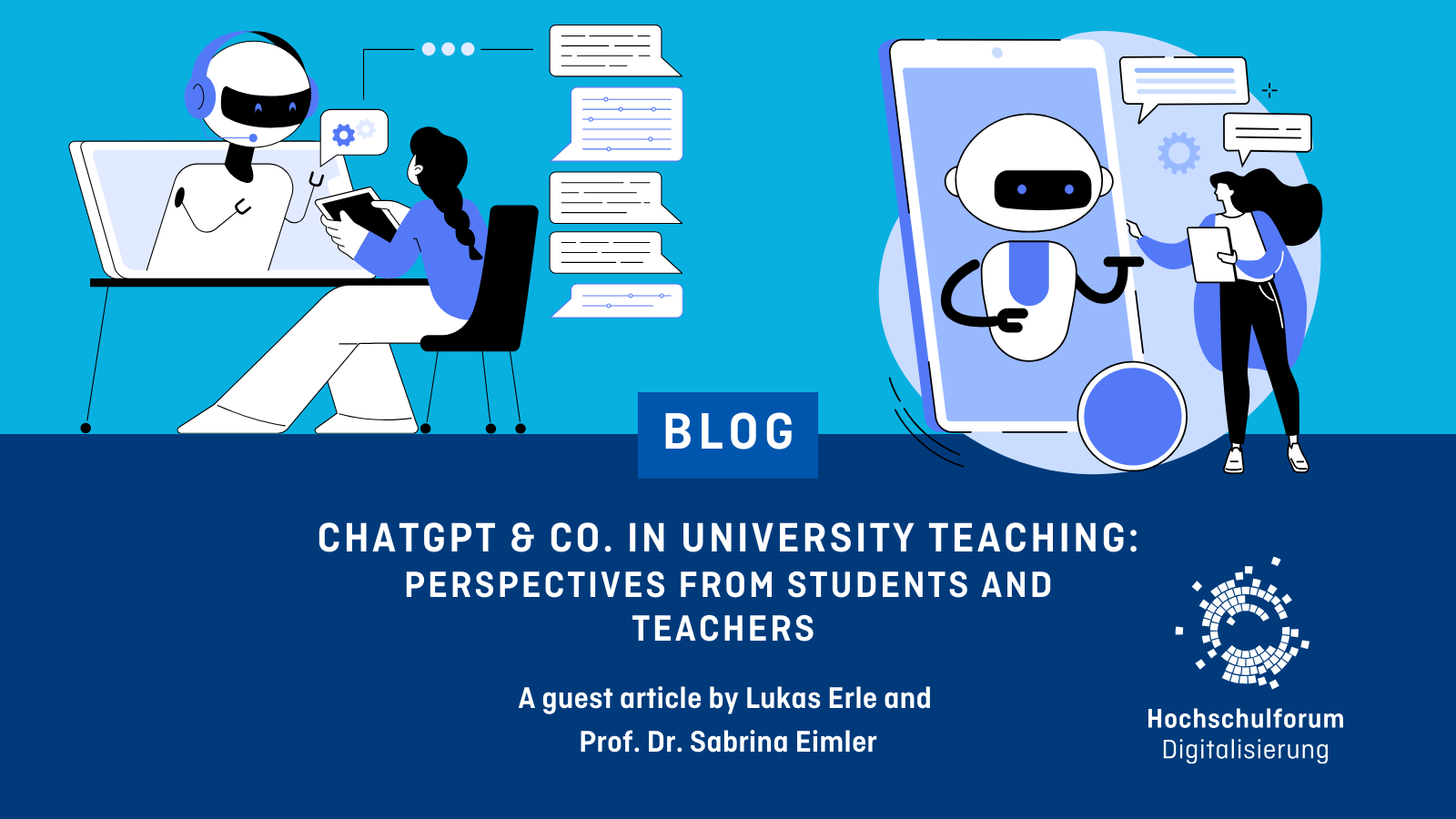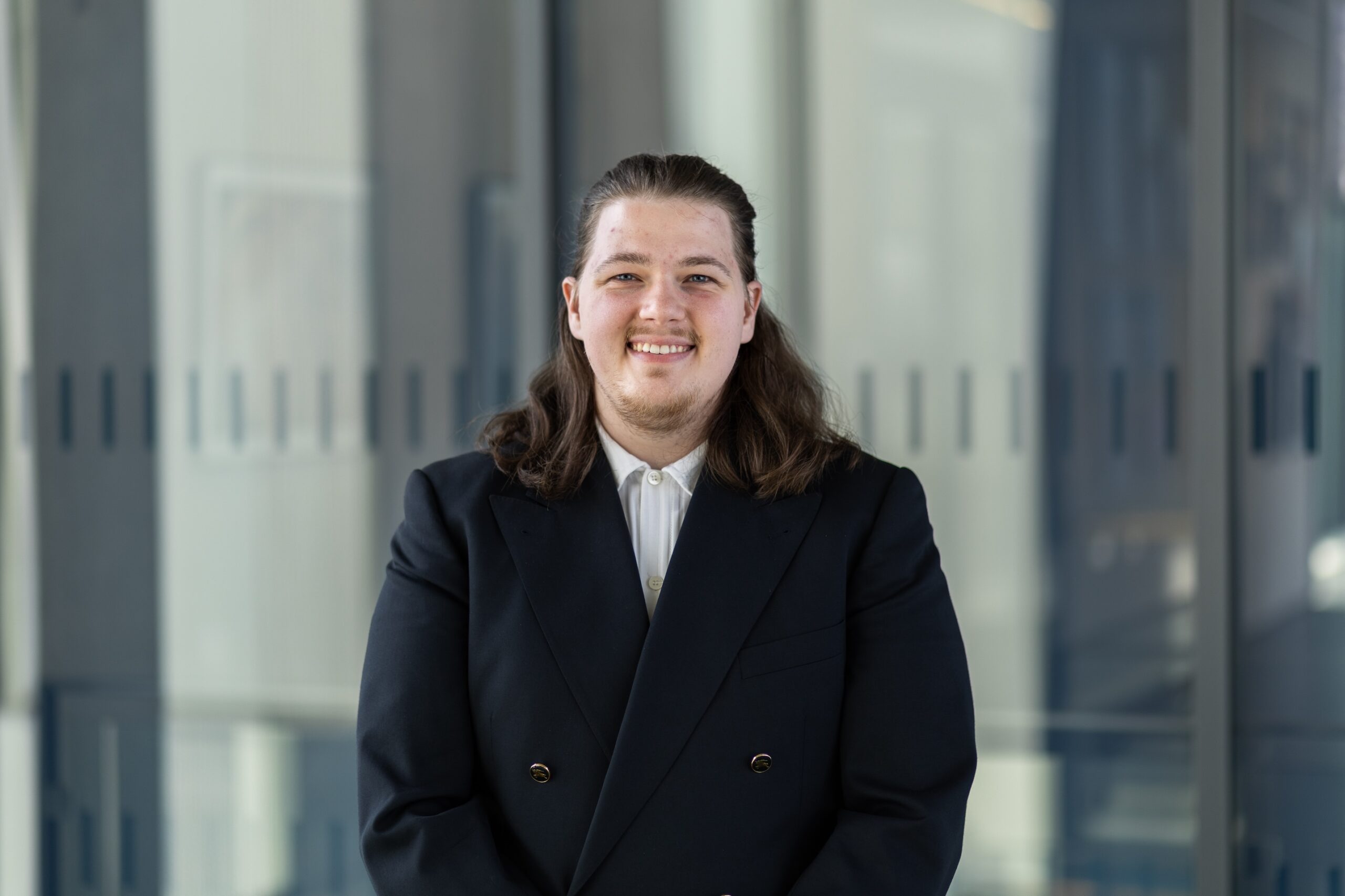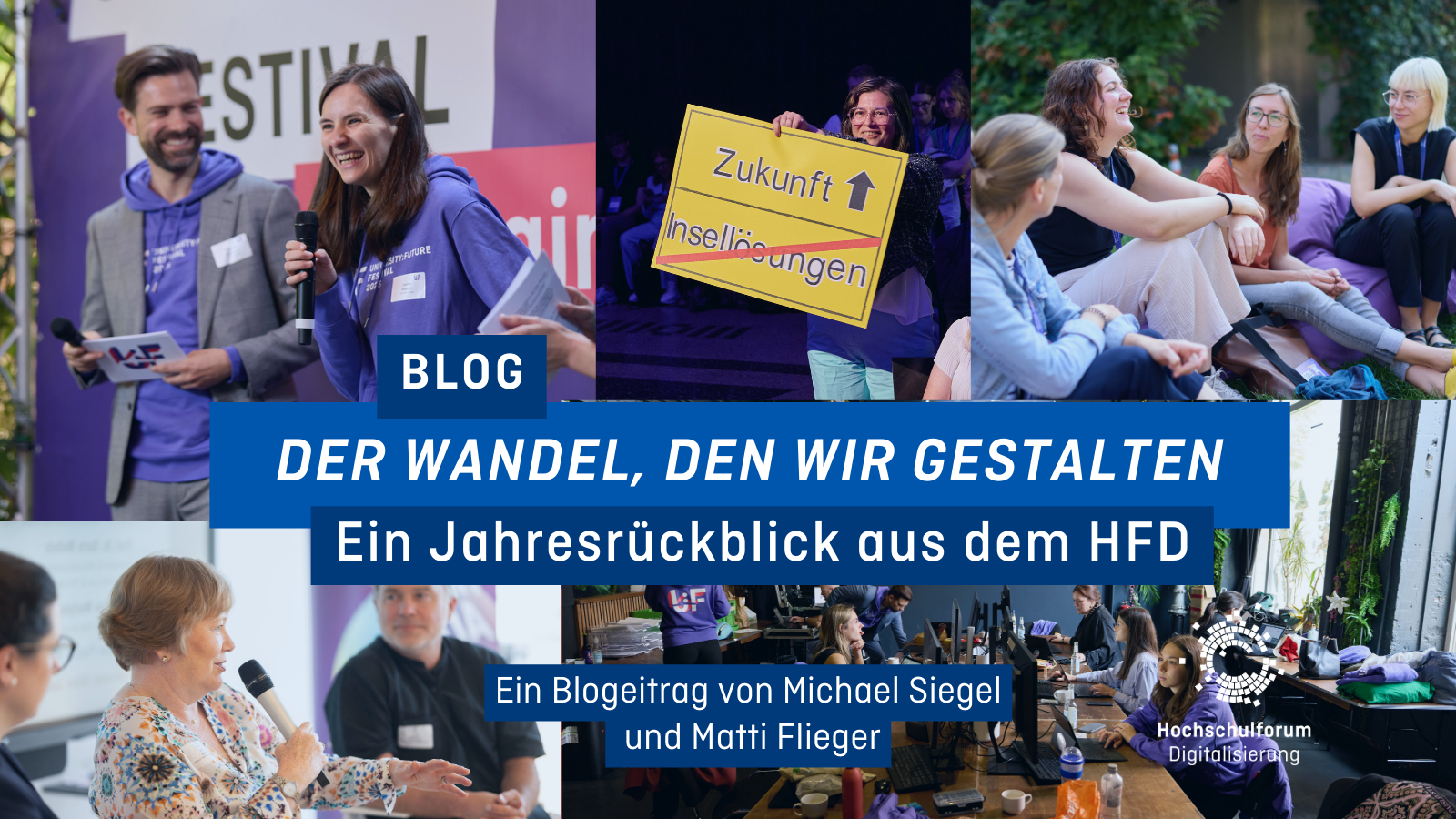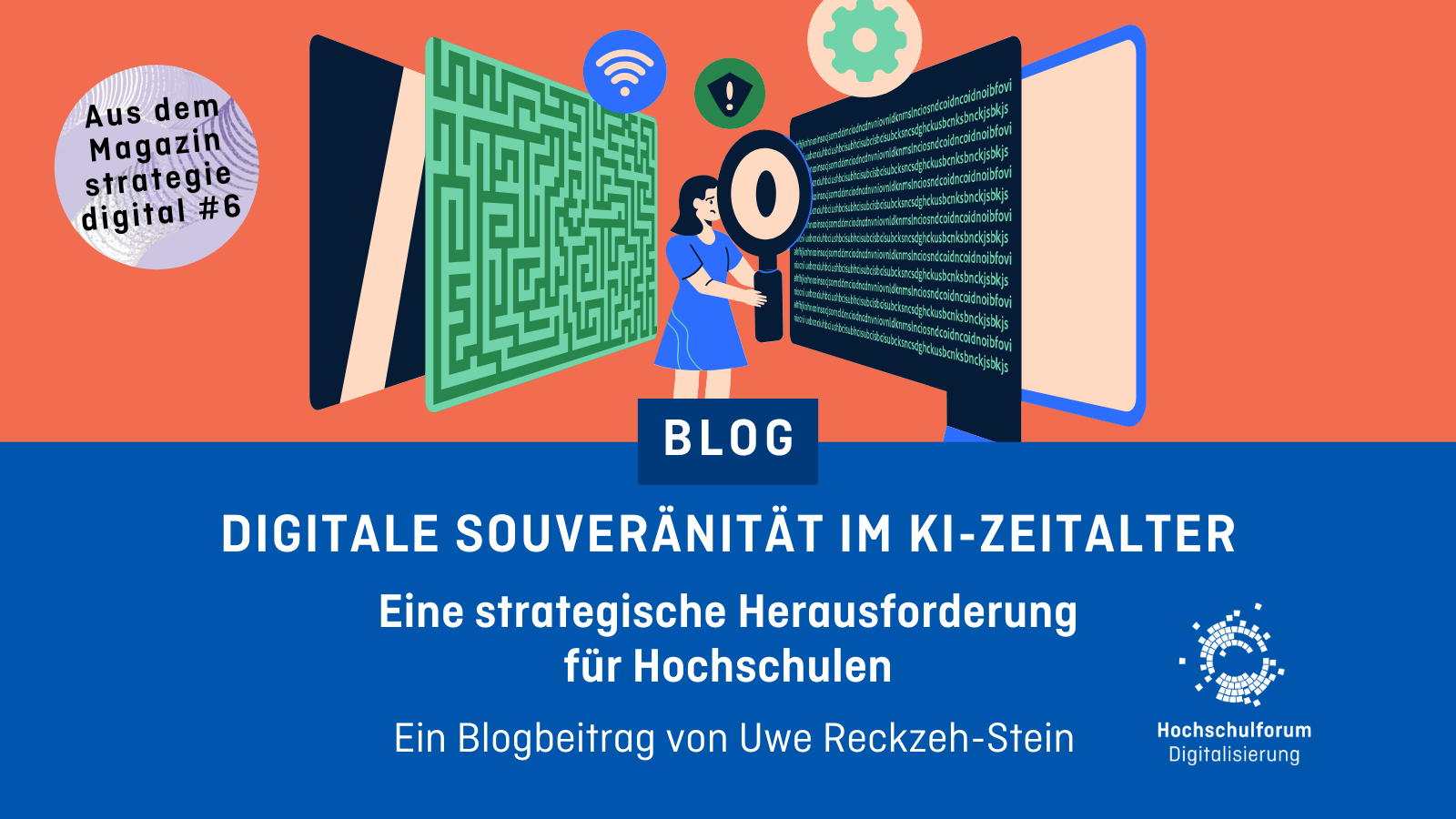ChatGPT and Co. in university teaching – perspectives from students and teachers
ChatGPT and Co. in university teaching – perspectives from students and teachers
09.07.24
The release of ChatGPT in November 2022 has led to the wider use of artificial intelligence (AI) reaching into the mainstream. AI tools have long since found their way into colleges and universities. But how do students and teachers actually view this change? What are the opportunities and challenges of using AI tools in university teaching?
Lukas Erle, Thomas Hoss and Prof. Dr. Sabrina Eimler (Department of Human Factors & Gender Studies at the Institute of Computer Science at the Ruhr West University of Applied Sciences in Bottrop) put these and other questions to students and teachers at various German colleges and universities. This article provides insights into the experiences and perspectives gathered to date from a total of 30 guided interviews.
(Generative) artificial intelligence – a brief definition
There are many different types and definitions. AI is a collective term for various computer systems and technologies that mimic human intelligence and can solve various problems. Large amounts of data are used to train algorithms to think like humans.
A very present subtype of AI that is often associated with the term is Generative Artificial Intelligence (engl. Generative Artificial Intelligencefor short: GenAI). GenAI is a form of AI in which multimedia content is generated. These can be texts, images, music and videos. The best-known example of a GenAI application is ChatGPT (Hu, 2023). This is an AI-supported chatbot that can generate a variety of text outputs through natural language conversations.
From the user’s point of view, most GenAI applications work in a very similar way: you enter a command of any length – a so-called prompt – into a user interface and, after a short time of generation, you receive the desired content, which you can further customize according to your needs. This very simple operation and the often free access to such applications is one of many reasons why GenAI applications are so popular.
Generative AI in the university context – who uses the applications and for what?
Students
Many students and teachers have long been using GenAI applications. The purposes of use differ slightly, and opinions on GenAI also differ within the two groups: Students from various fields of study (including computer science, psychology and teaching) stated that they themselves use GenAI applications or at least know of fellow students who use such applications. ChatGPT in particular is used by many students for various purposes: ChatGPT is most frequently used to support the formulation of texts and emails and to optimize the grammar and language of their own texts. Students on computer science courses also often use ChatGPT to check or debug code for programming tasks during their studies. A few students also state that they sometimes have entire tasks answered by ChatGPT so that they can understand them better. In this context, ChatGPT is often used by students from various disciplines to explain and repeat material, for example by uploading slide sets or scripts there and having them summarized by the AI.
When asked about the reasons for using GenAI, the reasons vary somewhat: Many students value GenAI applications as a learning support and formulation aid that is available any time and anywhere. However, a few students state that they feel they are at a disadvantage compared to their fellow students if they do not use GenAI applications. This is also noted by students who decide not to use these tools. These students emphasize that the lack of clear rules for using AI means that using it (feels) like an attempt to deceive and they therefore prefer not to use it.
Teachers

Opinions also generally differ among teachers: Many teachers use GenAI applications themselves, and here too ChatGPT is the most frequently used application. While most teachers use ChatGPT primarily for revising and optimizing texts, other teachers proactively integrate the application into their teaching. For example, several teachers report that they allow students to interact with the applications as part of their courses and jointly address the strengths and weaknesses of GenAI. The aim is to increase students’ media skills in relation to these applications through joint use and discussion and to teach them how to use them responsibly.
One lecturer even goes one step further and offers his students a customized learning assistant based on GenAI and trained with the content of his courses. This means that students can ask questions at any time and receive answers specifically tailored to the relevant courses. Many teachers justify their use of and involvement with GenAI with an interest in the continuous optimization of their own teaching and a general desire to always be at the cutting edge of technology. Some teachers also emphasize that they see it as their duty to be able to help students with questions about the applications and to teach them how to deal critically with GenAI applications. Only a few teachers refuse to use them completely. Those who refuse to do so justify this by referring to established teaching methods and the (subjective) irrelevance of AI for their own teaching areas.
GenAI in studies – revolution in learning or danger for learning?
In discussions with lecturers and students, there are initially some concerns that point to a possible threat to studies through the use of GenAI: For example, an unreflected use of GenAI tools can lead to a reduced mental engagement with the learning material. This concern is in line with research findings (Sok & Heng, 2023). Another problem is the lack of objectivity and reliability of GenAI applications: For example, ChatGPT can generate false information that sounds plausible but is actually fictitious. This is referred to as Hallucinating of the system (Randell & Coghlan, 2023). This is particularly problematic when ChatGPT is used to research literature or repeat material. Another problem is the often insufficiently diverse training data, which can lead to unequal treatment and misrepresentation of certain groups of people. This is referred to as Algorithmic bias (Baker & Hawn, 2021).
In addition to these challenges, students report concerns about penalties when using GenAI. At the same time, some students expect lower grades if they do not use the applications themselves but their fellow students do. Teachers do not share this concern, because a minimum level of understanding of the task is necessary to achieve really good results with the help of GenAI. Teachers expect weaker students in particular to benefit from GenAI applications, so that the gap between strong and weaker students becomes smaller. At the same time, they assume that particularly strong students will continue to be able to stand out from the crowd – with or without GenAI. Teachers are also sometimes concerned that excessive use could lead to addiction and a decline in thinking skills.
So does this mean that GenAI poses a serious threat to studying at German universities? Not necessarily, because teachers and students also see many opportunities for a revolution in learning in these challenges: While teachers sometimes have to spend a lot of time answering the sheer flood of written questions about their courses, personalized GenAI applications make it possible to advise students around the clock. Careful construction of prompts can reduce the tendency to hallucinate (Zheng et al., 2023). In addition, discussing the limitations and possibilities of GenAI together can ensure that the information provided is examined more closely. In addition, the possibility that written submissions can be written entirely by applications such as ChatGPT motivates a critical examination of existing examination formats. This results in the updating of tests that might otherwise never have taken place. The assumption of busywork tasks by GenAI can also give students and teachers more scope for creative and application-oriented learning.
So how should we deal with GenAI in the university context?
Having considered the status quo and the opportunities and challenges of GenAI, the question now arises as to the right way to deal with this technology. There is a broad consensus that a ban on GenAI in higher education is neither expedient nor enforceable. Enforceability fails because AI detectors are often very unreliable, and more often do not work at all (Walters, 2023); AI-generated texts cannot therefore be distinguished from human-generated content. At the same time, a ban would also lead to possible disadvantages in later working life: Many companies are increasingly investing in the use or development of AI (Schmidt, 2024) and the technology will have a far-reaching impact on the labor market (Göpfert, 2024). Students and lecturers therefore largely agree that knowledge of GenAI should already be built up during their studies.
So how do we deal with GenAI in our studies? First of all, it is important that universities and colleges engage in an exchange with their teaching staff and students. The first step should be to create clear framework agreements for use – the motto here is: Regulation instead of a ban. Possible regulations could include free use with marking of the text or code passages written by GenAI, in-depth explanations of the submissions in the form of oral presentations and critical discussions of the content generated by the AI.
In addition, universities and colleges should provide at least basic access – for example to free basic versions of the programs – for their students. Ideally, there could be campus licenses for paid versions so that there is no unequal access to GenAI applications. In addition to access, the integration of GenAI into basic scientific training is also important. For example, courses on scientific work should also include the possibilities and limitations, as well as existing regulations, in order to prepare students for these applications at the beginning of their studies.
In addition to courses and further training, which are particularly relevant for teachers from disciplines other than computer science, teachers also need the resources and freedom to try out and reinvent themselves. This is the only way to revise established forms of teaching and examination and adapt them to the new technical conditions. In addition, the interviews showed that there is a lack of knowledge among students and teachers about the perspective of the other side. This illustrates the need for an active exchange between the groups, because even initiating a dialog about GenAI sheds light on the diverse needs and experiences of students and teachers.
A quick summary
GenAI is on the rise and offers many opportunities for modernizing and enriching learning and teaching. However, various challenges require universities and colleges to agree on a common approach and framework rules with their members. The focus here is on regulated use, not a ban on these applications. An overview of the key points of both groups can be found in the table below.
| Students | Teachers | |
| Areas of application | GenAI is primarily used to support learning, formulating and processing (programming) tasks. | GenAI is used in courses to teach students how to use it responsibly. In individual cases, applications are actively used for innovative learning formats. |
| Opportunities | Many busywork tasks can be completed more quickly, texts can be linguistically revised and proofread. GenAI can also help with the understanding of complex topics. | Weaker students can improve their performance, established teaching and examination formats can be revised, Students can be better supported in learning and repeating content. |
| Concerns | Unclear rules of use lead to concerns, fairness of ratings is distorted. Relying on GenAI can lead to lazy learning. | Students may stop engaging with the content of their studies in greater depth and neglect the independent formulation of texts, etablished written submissions such as theses are no longer reliable forms of examination. |
| View of regulations | Regulations are generally sensible, but should not lead to a ban on GenAI. | Regulations are generally sensible, but a ban on GenAI is neither enforceable nor desirable. |
| Wishes | Clear rules for use, equal access to GenAI for all students, treatment of GenAI as part of the course, open exchange between students and lecturers. | Rules should be developed together with teachers, students and the university management, Teachers should be given the freedom to try out new forms of teaching and examinations and be supported through further training |
Baker, R. S., & Hawn, A. (2021). Algorithmic bias in education.International Journal of Artificial Intelligence in Education, 32(4), 1052-1092. https://doi.org/10.1007/s40593-021-00285-9
Göpfert, B. (2024, June 19). The change is imminent: Generative AI and the impact on the labor market. Handelsblatt Live. https://live.handelsblatt.com/der-wandel-steht-unmittelbar-bevor-generative-ki-und-die-auswirkungen-auf-den-arbeitsmarkt/
Hu, K. (2023). ChatGPT sets record for fastest-growing user base-Analyst note. https://www.reuters.com/technology/chatgpt-sets-record-fastest-growing-user-base-analyst-note-2023-02-01/
Randell, B., & Coghlan, B. (2023). ChatGPT’s Astonishing Fabrications About Percy Ludgate.IEEE Annals of the History of Computing, 45(2), 71-72. https://doi.org/10.1109/MAHC.2023.3272989
Schmidt, H. (2024, May 29). Half of German companies are investing in generative AI. F.A.Z. Pro: D:ECONOMY. https://www.faz.net/pro/d-economy/kuenstliche-intelligenz/haelfte-der-deutschen-unternehmen-zieht-investitionen-in-generative-ki-hoch-19749777.html
Sok, S., & Heng, K. (2023). ChaTGPT for Education and Research: A Review of Benefits and Risks. Social Science Research Network. https://doi.org/10.2139/ssrn.4378735
Walters, W. H. (2023). The effectiveness of software designed to detect AI-Generated writing: A comparison of 16 AI text detectors.Open Information Science, 7(1). https://doi.org/10.1515/opis-2022-0158
Zheng, Z., Zhang, O., Borgs, C., Chayes, J. T., & Yaghi, O. M. (2023). ChatGPT Chemistry Assistant for Text Mining and the Prediction of MOF Synthesis.Journal of the American Chemical Society, 145(32), 18048-18062. https://doi.org/10.1021/jacs.3c05819
Authors

Lukas Erle
Lukas Erle is a research assistant and lecturer for special tasks at the Institute of Computer Science at the Ruhr West University of Applied Sciences (HRW) in Bottrop. He studied Human-Technology Interaction (B.Sc.) at the Ruhr West University of Applied Sciences and Applied Cognitive and Media Science (M.Sc.) at the University of Duisburg-Essen. His research focuses on (generative) artificial intelligence and social robotics. In addition to leading media psychology modules, he is a project member of the RuhrBots Competence Center for Social Robotics, funded by the Federal Ministry of Education and Research, where he is responsible for examining human diversity and its influence on the use of technology.

Prof. Dr. Sabrina Eimler
Sabrina Eimler is Professor of Human Factors and Gender Studies at the Ruhr West University of Applied Sciences in Bottrop. She studied psychology, computer science, business administration and cultural studies at the University of Duisburg-Essen and earned her doctorate in media and social psychology. In particular, she teaches and researches VR and AR technologies, digital wellbeing, and online discrimination. She is a co-initiator of the Positive Computing Institute and an active driving force behind continuing education programs and courses of study (e.g., in the Innopreneurship master’s program at the University of Duisburg-Essen) in the area of digitization. Increasing the proportion of women in computer science and giving greater consideration to diversity are of particular concern to her.






 Michael Siegel
Michael Siegel 
 Andreas Giesbert
Andreas Giesbert 
 Uwe Reckzeh-Stein
Uwe Reckzeh-Stein 